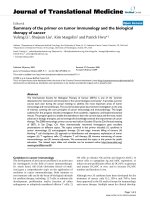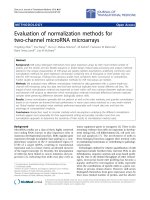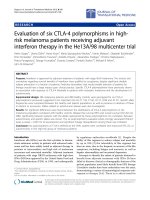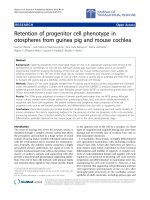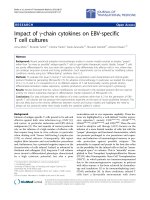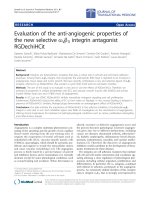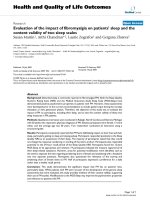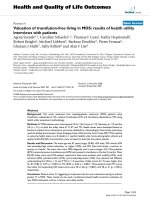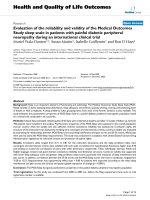Báo cáo hóa học: " Evaluation of upper extremity robot-assistances in subacute and chronic stroke subjects" doc
Bạn đang xem bản rút gọn của tài liệu. Xem và tải ngay bản đầy đủ của tài liệu tại đây (594.12 KB, 9 trang )
RESEA R C H Open Access
Evaluation of upper extremity robot-assistances in
subacute and chronic stroke subjects
Jaka Ziherl
*
, Domen Novak, Andrej Olenšek, Matjaž Mihelj, Marko Munih
Abstract
Background: Robotic systems are becoming increasingly common in upper extremity stroke rehabilitation. Recent
studies have already shown that the use of rehabilitation robots can improve recovery. This paper evaluates the
effect of different modes of robot-assistances in a complex virtual environment on the subjects’ ability to complete
the task as well as on various haptic parameters arising from the human-robot interaction.
Methods: The MIMICS multimodal system that includes the haptic robot HapticMaster and a dynamic virtual
environment is used. The goal of the task is to catch a ball that rolls down a sloped table and place it in a basket
above the table. Our study examines the influence of catching assistance, pick-and-place movement assistance and
grasping assistance on the catching efficiency, placing efficiency and on movement-dependant parameters: mean
reaching forces, deviation error, mechanical work and correlation between the grasping force and the load force.
Results: The results with groups of subjects (23 subacute hemiparetic subjects, 10 chronic hemiparetic subjects
and 23 control subjects) showed that the assistance raises the catching efficiency and pick-and-place efficiency.
The pick-and-place movement assistance greatly limits the movements of the subject and results in decreased
work toward the basket. The correlation between the load force and the grasping force exists in a certain phase of
the movement. The results also showed that the stroke subjects without assistance and the control subjects
performed similarly.
Conclusions: The robot-assistances used in the study were found to be a possible way to raise the catching
efficiency and efficiency of the pick-and-place movements in subacute and chronic subjects. The observed
movement parameters showed that robot-assistances we used for our virtua l task should be improved to maximize
physical activity.
Background
Loss of motor control is a common consequence o f
stroke [1] and results in many difficulties when perform-
ing activities of daily living. Several studies have shown
that the use of rehabilitation robotics can improve recov-
ery [2-4]. The benefit of such robots is twofold. First,
they can provide objective measurements of the time-
course of changes in motor control of the affected limb
[5,6]. Second, robots with active motors can be pro-
grammed to implement a variety of highly reproducible,
repetitive movements and training protocols, allowing
patients to semiautonomously practice their movement
training [7]. The first device that provided robotic
assistance in rehabilitation was the MIT-Manus [8],
a 2-degree-of-freedom system that supports planar
movements using an impedance controller. The MIT-
Manus is augmented with several game-like virtual envir-
onments that transform therapy into a fun activity. A
more complex device is the MIME [9], which includes
several modes of robot-assist ed movement: passive,
active-assisted and active-constrained. The MIME allows
measurement of interaction forces, kinematics, average
work per trial and force directional error. Other well-
known systems are the ARM Guide [10], which measures
and applies assistive or resistive forces to linear reaching
movements, and the ADLER [11], which is used to
measure the natural wrist movement trajectories seen in
real-life functional tasks.
Studies with the aforementioned devices showed that
robot-assisted therapy can impro ve recovery in t he long
run for both subacute and chronic patients [3,12-15].
* Correspondence:
Laboratory of Robotics, Faculty of Electrical Engineering, University of
Ljubljana, Trzaska c. 25, 1001 Ljubljana, Slovenia
Ziherl et al. Journal of NeuroEngineering and Rehabilitation 2010, 7:52
/>JNER
JOURNAL OF NEUROENGINEERING
AND REHABILITATION
© 2010 Ziherl et al; licensee BioMed Central Ltd. This is an Open Access article distributed under the terms of the Creative Commons
Attribution License (http://creativecommons.o rg/licenses/by/2.0), which permits unrestricted use, distribution, and reproduction in
any medium, provided the original work i s properly cited.
Additionally, studies introduced some common mea-
sures of performance when using rehab ilitation robots
as a measuring tool. Casadio et al. [16] estimated the
movement duration, linearity of the movement and sym-
metry of the movement. Harwin et al. [2] listed time to
reach a target, the number of velocity peaks, the average
or summed interface force with the robot as examples.
The study using the MIME robotic device [9] also
observed the force in the direction of the movement
and average work per trial. If we extend the measures to
grasping, the correlation between the grasping and load
force has been often employed in research of human
motion and grasping [17,18] as a measure of the level of
coordination between grasping and movement.
Most of these studie s focused on observing the effects
of robotic assistance under controlled circumstances.
Subjects performed repetitive, predefined arm move-
ments in the robot workspace. Our study includes a
complex virtual task: a dynamic environment where
movements are subjective and not fully predictable,
requiring the subject to be focused and perform consid-
erable physical activity. The aforementioned studies
were previously focused o n reaching movements and
pick-and-place movements while object grasping was
not included. The grasping component is also i mple-
mented in our virtual task. The rehabilit ation outcome
of robot-aided therapy compared to classical therapy has
already been investigated, so this is not the purpose of
this study. The goal of our work was to implement dif-
ferent modes of rob ot-assistance in a complex virtual
environment and evaluate how they a ffect the subjects’
ability t o complete the task. We were interested in the
impact of various haptic parameters included in the
human-robot interaction. Catching efficiency and pick-
and-place efficiency are chosen as the indicators of the
task performance. Mean reaching forces, deviation error,
mechanical work and correlation between the grasping
force and the load force are the observed parameters of
the human-robot interaction.
Methods
MIMICS MMS System specification
The MIMICS multimodal system with the HapticMaster
robot (Moog FCS Inc.) was used in the study. This sys-
tem has alre ady been used in a study where psychophy-
siological responses were measured and evaluated in
stroke subjects [19]. It is an admittance-controlled
end-effector-based haptic interface with one rotational
and two translational degrees of freedom. A grasping
mechanism is attached to a gimbal that allows reorienta-
tion of the subject’s hand. The mechanism is upgraded
with a one degree of freedom finger opening and closing
subsystem in order to provide grasping and object
carrying capabilities. The hand opening and closing sub-
system can be inverted, making the exercise possibl e for
left-and right-handed subjects. Support of the lower and
upper arm is provided by an active gravity compensation
mechanism. The graphic environment is presented
to the subject on a back-projection screen via LCD
projector.
Subjects
Twenty-three subacute hemiparetic subjects (age 51.0 ±
13.3 years, age range 23-69 years, 16 males, 7 females),
ten chronic hemipa retic subjects (age 45.6 ± 13.0, age
range 30-71 years, 8 males, 2 females) and a control
group ( twenty-three subjects, age 50.5 ± 12.6 years, age
range 24-68 years, 16 m ales, 7 females) participated in
the study. As a result of the stroke, 13 subacute subjects
suffered from hemiparesis of the left side of the body
and 10 suffered from hemiparesis of the right side. All
were right-handed before the stroke. Six chronic sub-
jects suffered from hemiparesis of the left side of the
body and 4 suffered from hemiparesis of the right side.
They were also all right-handed before the stroke. The
stroke subjects were undergoing motor rehabilitation at
the University Rehabilitation Institute of the Republic of
Slovenia in Ljubljana. The subjects in control group had
no physical or cognitive deficits. All were right-handed.
To better match the control group and the subacute
stroke group, 13 controls performed the tasks with their
left hand while 10 performed the tasks with their right
hand.
Experiments
Before the study began, ethical approval was obtained
both from the National Medical Ethics Committee of
theRepublicofSloveniaandfromtheMedicalEthics
Committee of the University Rehabilitation Institute of
the Republic of Slovenia. The rehabilitation task is a
catch-and-place exercise. An inc lined table is positioned
in a room with several objects in the scene (Figure 1).
A small sphere and two small cone s on the left and
right sides of the sphere represent the current position
of the robot end-point in the virtual environment. The
robot end-point is the point at the top of the robot
where the grasping mechanism is attached to the robot.
When the subject squeezes th e grasping mechanism, the
cones move closer together and when the subject
releases it, the cones move farther apart. A ball rolls
from the opposite side of the table. The subject needs to
catch the ball and place it in a basket which appears
when the b all is g rasped. After the ball is successfully
placed in the basket, a new ball rolls down the inclined
table. The task is a combination of catching, grasping,
pick-and-place movement and releasing.
Ziherl et al. Journal of NeuroEngineering and Rehabilitation 2010, 7:52
/>Page 2 of 9
The task includes different options of robot-assistance.
These include:
1. Catching assistance. The catching assistance
helps the subject to reach the catching point. It i s
realized by the use of an impedance controller that
moves the subject’s arm in the frontal plane. The
assistance generates the forces wh en the ball re aches
the center of the table, thus giving the subject
enough time to reach the catching point by him/her-
self. The force increases as the ball gets closer to the
robot end-effector.
2. Grasping assistance. Instead of the manual grasp-
ing, the grasping assistance causes the ball to stick to
the virtual gripper. When the subject reaches the
basket, the ball is dropped automatically. If the
grasping assistance is disabled, the grasping force
produced by the subject needs to be higher than a
reference force. The reference force can be changed
during the task according to the subject’sgrasping
ability.
3. Tunnel assistance. The haptic trajectory tunnel
enables movement from the catching point to the
placing point along a predefined trajectory in a vir-
tual haptic environment. An impedance controller
prevents the subject from deviating largely from the
desi red trajectory. The bisector of the tunnel is gen-
erated using B-splines and control points. The con-
trol points are approximated by using B-splines from
trajectories measured in healthy subjects’ movements
[20]. The guidance assistance provides a force in the
direction of the haptic trajectory tunnel. An impe-
dance controller leads the subject’ sarmalongthe
desired trajectory.
The subjects first tested the virtual rehabilitation
environment task for 2 minutes to familiarize them-
selves with it and find out if they were unable to per-
form a particular component of the task. They were
instructed to try as hard as possible while avoiding
extremely tiring or painful activity. The assistances were
activated by a therapist based on the testing and stayed
the same during the 6-minute training session. There-
fore, 7 subacute subjects had grasping assistance, 5 had
catching assistance and 7 had tunnel assistance. Seven
chronic subjects had grasping assistance, 4 had catching
assistance and 5 had tunnel assistance. The control
group performed the task without any assistance. Several
haptic parameters were measured during training
including robot positions, interaction forces between
the robot end-point and user, grasping force, position of
the ball and a p arameter which indicates the task states
(the ball is caught, the ball is placed, the ball is missed).
Evaluation parameters and data analysis
The positions of the robot and the forces were
smoothed with a weighted moving average filter (25
weighted sample s, all weights equal to 1/25) during the
task. The control loop executed at 2500 Hz while the
data were sampled at 100 Hz. To analyze performance
of the subjects, we observed the following indicators:
1. Efficiency. The catching efficiency is the percen-
tage of caught balls divided by the number of all
balls. The placing efficiency is the percentage of the
balls which were successfully placed in the basket
divided by the number of caught balls.
2. Mean Reaching Forces. The mean reaching forces
at the end-effector sensor can provide information
about the direction of the in tended movement. These
forces were assessed from the time the ball reached
the center of the table to the time the ball was caught.
The sign of the force is set with respect to the
position of the ball. The positive sign represents the
force toward the ball, while the negative sign repre-
sents the force away from the ball. Only the horizon-
tal component of t he force was observed since this
component represents the left-right movement of the
subject’s arm.
3. Deviation Error.Thisisthepercentageofthe
maximal deviation of the measured movement
trajectory from a reference line normalized by the
reference line length. The reference line is the cen-
tral line of the tunnel.
Figure 1 Rehabilitation system.Asubjectperformingthevirtual
rehabilitation task. The subject performs the task using the robot (1)
and grasping device (2) while his/her arm is gravity compensated (3).
The screen (4) shows an inclined table, a ball (5) and a basket (6).
Ziherl et al. Journal of NeuroEngineering and Rehabilitation 2010, 7:52
/>Page 3 of 9
4. Mechanical Work. The mechanical work is com-
puted from the measured forces at the end-effector
and the end-effector positions. The computed work
evaluates the interaction between the subject and
the haptic robot. Therefore, it is not only the
mechanical work performed by the subject. The
interaction work toward the target and away from
the target were distinguished. The work away from
the target represents the resisti ve work when the
guidance assistance is enabled.
5. Correlation between the grasp force and the
load force. The grasping forces measured during a
single pick-and-place movement are divided into
three phases: grasping phase, transport phase and
release pha se. The characteristic point of the grasp-
ing phase is when the grasp force reaches the rising
time end-point. Rise time is the time required for
the grasping force to chang e from 10% value to 90%
value. The characteristic point of the transport phase
time is the central point between the grasp and the
release. The characteristic point of the release phase
is th e fall time end-point. Fall time is de fined as the
time required for the grasping force to change from
90% value to 10% value. The load force is the verti-
cal component of the end-effector force applied by
the subject. Pearson correlation coefficients were
computed between the grasping force and the load
force for each grasping phase and for each trial. This
measure is considered as a sensitive parameter for
precision of the coupling bet ween the grasping and
load force [18]. A tight coupling is seen in different
movements of varying length and direction [21].
For each analyzed parameter, a one-way ANOVA was
first used to compare the three groups without assis-
tance (control, stroke, chronic). Then, a two-way
ANOVA (assistance × group) was used to evaluate the
effect of different modes of haptic assistance (enabled/
dis abled) on each parameter for both groups (subacute/
chronic). Bonferroni corrections were used in post-hoc
tests. The control group was not included in the two-
wayANOVAsincenocontrolsusedanykindofhaptic
assistance.
Results
Catching
Comparison of the three groups without catching assis-
tance (controls, subacute, chron ic) revealed significant
differences in both catching efficiency and mean reach-
ing forces (Table 1). For catching efficiency, post-hoc
tests found that the control group caught more balls
than the subacute group (p < 0.001) whil e the difference
between control and chronic groups was not significant.
For mean reaching forces, controls applied lower forces
than both the subacute (p = 0.004) and control (p =
0.003) groups. Two-way ANOVA (catching assistance ×
group) found a sign ificant main effect of catch ing assis-
tance on catching efficiency (p = 0.037), with no signifi-
cant differences between subacute and chronic groups
as well as no group-assistance interaction.
Pick-and-place movements
Comparison of the three groups without tunnel assis-
tance (controls, subacute, chron ic) revealed significant
differences in pick-and-place efficiency, deviation error
and work toward the target (Table 2). Post-hoc tests
found that the control group performed pick-and-place
movements more successfully than both the subacute
and chronic groups (p < 0.001 in both cases). The
chronic group had a lower deviation error and per-
formed more work toward th e target than both the sub-
acute and control groups (p < 0.001 in all cases).
Figure 2 shows the deviation error of the stroke subjects
with and without tunnel assistance as w ell as the devia-
tion e rror of the control group. The end-effector force,
the velocity of the end-effector, the work toward ta rget
and the work away from target in the tangential direc-
tion of the tunnel a re presented in Figure 3. They are
shown for one subacute subject without assistance, one
subacute subject with tunnel assistance and one control
group subject. The time from pick to place point is nor-
malized. Figure 4 shows the work performed toward the
Table 1 Catching
Subacute
dCA
(n = 18)
Subacute
CA
(n = 5)
Chronic
dCA
(n = 6)
Chronic CA
(n = 4)
Control
dCA
(n = 23)
CE [%] 63 ± 17 86 ± 14 62 ± 21 78 ± 27 86 ± 13
MF [N] 0.26 ± 0.26 -0.28 ± 0.51 0.11 ± 0.15 -0.42 ± 0.43 0.03 ± 0.07
The results of observed catching efficiency (CE) and mean forces (MF) during
the catching phase of the task. The subacute and chronic subjects are divided
into the groups with catching assistance (CA) and without catching assistance
(dCA). n is the number of subjects.
Table 2 Pick-and-place movement
Subacute
dTA
(n = 16)
Subacute
TA
(n = 7)
Chronic
dTA
(n = 5)
Chronic
TA
(n = 5)
Control
dTA
(n = 23)
PE [%] 79 ± 14 98 ± 6 78 ± 16 100 ± 0 91 ± 9
DE [%] 37.9 ± 16.4 6.9 ± 1.8 29.4 ± 18.2 7.4 ± 3.4 39.4 ± 26.8
WTT [J] 1.39 ± 0.65 0.12 ± 0.38 1.87 ± 1.55 0.01 ± 0.17 1.23 ± 0.91
WAT [J] 0.02 ± 0.40 0.18 ± 0.28 0.19 ± 0.38 0.66 ± 0.83 0.03 ± 0.27
The results of placing efficiency (PE), deviation error (DE), work performed
toward the target (WTT) and work performed away from the target (WAT).
The subacute and chronic subjects are divided into the groups with tunnel
assistance (TA) and without tunnel assistance (dTA). n is the number of
subjects.
Ziherl et al. Journal of NeuroEngineering and Rehabilitation 2010, 7:52
/>Page 4 of 9
target while Figure 5 shows the work performed away
from the target for single pick-and-place movements.
Two-way ANOVA (tunnel assistance × group) found
significant main effects of tunnel assistance on pick-
and-place efficiency (p = 0.011), deviation error (p <
0.001), work toward the target (p < 0.001) and work
away from the target (p < 0.001). Significant main effects
of group (subacute/chronic) were observed on work
towardthetarget(p=0.003)andworkawayfromthe
target (p < 0.001). Significant interaction effects were
observed on work toward the target (p = 0.003) and
work away from the target (p < 0.001).
Grasping
Figure 6 shows the grasping force and the load force
during pick-and-place movement in virtual task training
for one subacute subject. The forces are observed for
grasping, transport and release phase. The Pearson cor-
relation coefficient is computed for each movement in
each phase (Table 3). The correlations for the subacute,
chronic and control groups are shown in Figure 7. Only
the subjects who had grasping assistance disabled are
considered. While the correlations a re widely spread
from -1 to 1 in the g rasping and t ransport phase, the
correlation between grasp force a nd load force exists in
release phase. These results are shown for subacute,
chronic and control groups. While there are no signifi-
cant differences among groups in grasping and release
phases (p = 0.210; p = 0.218), there is a significant dif-
ference between the control group and the oth er two
groups during transport phase (p < 0.001 for both
cases). There is a differenceingraspingrisetime
between the subacute and control groups (p = 0.004).
Therisetimeofthegraspingforceislongerinthe
chronic group than in control (p < 0.001) or subacute
group (p < 0.001). These relationships are similar for
the fall time of the grasping force. There are no differ-
ences between subacute and control group (p = 0.481)
while the chronic group had a longer fall time compared
to subacute (p < 0.001) and control (p < 0.001) groups.
Subacute dTA Subacute TA Chronic dTA Chronic TA Control dTA
0
20
40
60
80
100
120
Deviation error [%]
Figure 2 Deviation error. Deviation error of the pick-and-place
movement with respect to the predefined central curve line. The
results are shown for subacute, chronic and control group without
tunnel assistance (dTA) as well as for subacute and chronic group
with tunnel assistance (TA).
0 50 100
-10
0
10
0 50 100
-0.1
0
0.1
0 50 100
0
1
2
0 50 100
0
0.3
0.6
Normalized time
(c) Control dTA
0 50 100
-10
0
10
0 50 100
-0.1
0
0.1
0 50 100
0
1
2
0 50 100
0
0.3
0.6
Normalized time
(b) Subacute TA
0 50 100
-10
0
10
Force [N]
0 50 100
-0.1
0
0.1
Velocity [m/s]
0 50 100
0
1
2
WTT[J]
0 50 100
0
0.3
0.6
Normalized time
WAT [J]
(a) Subacute dTA
Figure 3 Measured movement parameters. Comparison of measured parameters in a subacute dTA subject (a), a subacute TA subject (b) and
a control subject (c). The end-effector force, the movement velocity, the work toward target (WTT) and the work away from target (WAT) are
shown. The parameters are observed in the tangential direction on the central curve line. The lines represent different trials for the same subject.
Ziherl et al. Journal of NeuroEngineering and Rehabilitation 2010, 7:52
/>Page 5 of 9
Discussion
As expected, results showed that the stroke subjects had
lower catching efficiency than the control group. The
subjects reached the same level of efficiency when the
cat ching assistance was applied. Therefore, the catching
assistance is a promising tool in certain phase of rehabi-
litation t o raise the efficiency even if it is realized by a
simple impedance controller. On the other hand, the
mean catching forces showed that the interaction force
pointed in the opposite direction when the assistance
guided the subject. In most cases, this means that the
subjects let the assistance make the movement without
making any effort themselves. The reason why con trol
subjects had such low mean forces is that they usually
reached the right spot before the ball came into the
catching zone. A more complex adaptive assistance
model could be the answer to decrease this parameter
[22]. Adaptive control algorithms adapt the controller
parameters based on measurements of the subjects’s
performance. Therefore, the assistance is automatically
tuned to the subject’s individual needs.
The relationships between groups in placing efficiency
are similar, e xcept for the subjects with tunnel assis-
tance who had close to 100% efficiency. The deviation
error showed that the tunnel greatly limits the move-
ments while the linearity error range in other groups
was extended. The control, subacute dTA, and chronic
dTA subjects chose the movements that strayed far
away from the central line of the tunnel. These findings
show that limiting the pick-and-place movement with a
haptic tunnel is not the best type of aid at least for this
virtual task. In Figure 3, we can see that the peaks of
the measured force toward the target are greater in sub-
acute dTA and control subjects than in subacute TA
subjects. The positive and negative force of the subacute
subject s with th e tunnel assistance was in the same pro-
portion while the subjects without the tunnel had
mainly positive measured forces. Also, the velocity peaks
in the direction toward target are greater in subacute
dTA and co ntrol subjects than in subacute TA subjects.
The velocity profiles are more linear in the subacute
subjects who had the tunnel assistance. The tunnel
assistance therefore limits the velocity of the pick-and-
place movements. The resistive work prevailed th e work
toward target when the guidance was applied. Therefore,
the robot performed most of the movement while the
subject was passive. The question remains if the gui-
dance assistance should be applied to the subjects
[23,24]. If the subject is not able to perform the move-
ment, the assistance is definitely needed. Other studies
showed that adaptive guidance assistance could present
a more suitable option [13,23]. However, the haptic tun-
nel could be an adequate assistance for initial motor
learning. The subjects who needed tunnel assistance
should train with easier tasks. In our opinion, easier
tasks present a better solution than the false feeling of
the s ubject that he or she is able to perform the move-
ment in a more complex task while the rob ot accom-
plishes all the necessary work.
The grasping force parameters were examined for the
subjects withou t the grasping assistance. The chronic
group had longer rise and fall times than the other two
groups. The results showed that the correlation between
Subacute dTA Subacute TA Chronic dTA Chronic TA Control dTA
0
0.5
1
1.5
2
2.5
3
3.5
4
Work toward target [J]
Figure 4 Work toward the target. Comparison of the performed
work toward the target during pick-and-place movement for the
subacute, chronic and control group with disabled tunnel assistance
(dTA). The results of chronic and subacute group with tunnel
assistance (TA) are also shown.
Subacute dTA Subacute TA Chronic dTA Chronic TA Control dTA
0
0.5
1
1.5
2
2.5
3
3.5
Work away from target [J]
Figure 5 Work away from the target.Comparisonofthe
performed work away from the target during pick-and-place
movement for the subacute, chronic and control group with
disabled tunnel assistance (dTA). The results of chronic and
subacute group with tunnel assistance (TA) are also shown.
Ziherl et al. Journal of NeuroEngineering and Rehabilitation 2010, 7:52
/>Page 6 of 9
the load force and the grasping force exists in the release
phase. The correlation is not evident in the other two
phases. These results are specific for our dynamic task,
while other studies s howed high correlation al ong the
whole movement [17,18]. Of course, the types of the
tasks in these studies were differ ent from ours. This sug-
gests that correlation could be dependant on the task
type. Momentary grasping assistance showed no signifi-
cant changes in the groups that had the assistance, so
anothe r type of grasping assistance could be adequate. If
we compare all results among the groups, the subacute
group withou t any assistance had comparable results
with control group. The chronic group without any assis-
tance deviated more, but the number of subjects in this
group is smaller.
Conclusions
Various clinical studies with robotic devices showed that
robot-assisted therapy can improve recovery. Our study
was aimed at studying the influence of robotic assistance
in a dynamic virtual environment. Rehabilitation robots
with their measurement possibilities provide objective
performance information. The results of the observed
evaluation parameters showed significant differences
when different robot-assistive modes were applied to the
subjects. Properly applied robot-assistive modes enabled
the subject to focus on a particular function of the exer-
cise, such as reaching or grasping, or coordinated
actions that combine reaching and grasping. In c linical
environments, it is import ant to appropriately customize
the difficulty level in a way to a meet particular patient’s
performance capabilities. An interesting virtual environ-
men t might increa se motivation and change the rehabi-
litation into a fun activity for some subjects as well. In
the future, adaptive robot-assistance for pick-and-place
0 0.5 1
0
20
40
60
Grasp force [N]
0 0.5 1
−10
0
10
20
30
40
50
60
0 0.5 1
0
20
40
60
0 0.5 1
−5
0
5
10
15
Load force [N]
Time gPh [s]
0 0.5 1
−5
0
5
10
15
Time tPh [s]
0 0.5 1
−5
0
5
10
15
Time rPh [s]
Figure 6 The grasping force and the load force. The grasping force and the load force dur ing pick-and-place movement for grasping phase
(gPh), transport phase (tPh) and release phase (rPh). The movements were performed by a subacute subject who had no grasping assistance.
Each line represents the force during single pick-and-place movement.
Table 3 Grasping
Subacute dGA
(n = 16)
Chronic dGA
(n = 3)
Control dGA
(n = 23)
RT [s] 0.14 ± 0.45 0.47 ± 0.40 0.17 ± 0.34
FT [s] 0.33 ± 0.30 0.54 ± 0.15 0.29 ± 0.39
CGP [-] 0.03 ± 0.58 0.23 ± 0.58 0.12 ± 0.58
CTP [-] 0.01 ± 0.51 -0.36 ± 0.59 0.41 ± 0.58
CRP [-] 0.90 ± 0.40 0.88 ± 0.42 0.89 ± 0.30
Results for grasping force rise time (RT), grasping force fall time (FT),
correlation between grasp force and load force for grasping phase (CGP),
transport phase (CTP) and release phase (CRP). These groups had grasping
assistance disabled (dGA). n is the number of subjects.
Ziherl et al. Journal of NeuroEngineering and Rehabilitation 2010, 7:52
/>Page 7 of 9
movements as well as for grasping assistance will be
implemented, to continuously adapt to patient’s capabil-
ities during the upper extremity rehabilitation.
Acknowledgements
The work was funded by the EU Information and Communication
Technologies Collaborative Project MIMICS grant 215756. Moog FCS kindly
loaned one of two HapticMaster devices for the MIMICS project. The authors
acknowledge the financial support from the state budget by the Slovenian
Research Agency (ARRS).
Authors’ contributions
The overall design of the experiments was agreed by all the authors. JZ, AO
and MMi developed all related programs and implemented the study. DN
carried out the experiments and performed the statistical analysis. JZ and
MMu analyzed the data and drafted the manuscript. All authors read and
approved the manuscript.
Competing interests
The authors declare that the y have no competing interests.
Received: 16 April 2010 Accepted: 18 October 2010
Published: 18 October 2010
References
1. Heart disease and stroke statistics-2009 update: A report from the
American Heart Association Statistics Committee and Stroke Statistics
Subcommittee. Circulation 2009, 119:23-182.
2. Harwin W, Patton J, Edgerton V: Challenges and Opportunities for Robot-
Mediated Neurorehabilitation. Proceedings of the IEEE 2006, 94:1717-1726.
3. Volpe B, Krebs H, Hogan N, Edelstein L, Diels C, ML A: Robot training
enhanced motor outcome in patients with stroke maintained over 3
years. Neurology 1999, 53:1874-1876.
4. Prange G, Jannink M, Groothuis-Oudshoorn C, Hermens H, Ijzerman M:
Systematic review of the effect of robot-aided therapy on recovery of
the hemiparetic arm after stroke. Journal of Rehabilitation Research and
Development 2006, 43:171-184.
5. Liebermann D, Buchman A, Franks I: Enhancement of motor rehabilitation
through the use of information technologies. Clinical biomechanics 2006,
21:8-20.
6. Johnson M: Recent trends in robot-assisted therapy environments to
improve real-life functional performance after stroke. Journal of
NeuroEngineering and Rehabilitation 2006, 3.
7. Vergaro E, Casadio M, Squeri V, Giannoni P, Morasso P, Sanguineti V: Self-
adaptive robot training of stroke survivors for continuous tracking
movements. Journal of NeuroEngineering and Rehabilitation 2010, 7:13.
8. Hogan N, Krebs H, Charnnarong J, Srikrishna P, Sharon A: MIT - MANUS: A
workstation for manual therapy and training I. Robot and Human
Communication, 1992. Proceedings., IEEE International Workshop on 1992,
161-165.
9. Lum P, Burgar C, Shor P: Evidence for improved muscle activation
patterns after retraining of reaching movements with the MIME robotic
system in subjects with post-stroke hemiparesis. IEEE Transactions on
Neural Systems and Rehabilitation Engineering 2004, 12:186-194.
10. Reinkensmeyer D, Kahn L, Averbuch M, McKenna-Cole A, Schmit B,
Rymer W: Understanding and treating arm movement impairment after
chronic brain injury: Progress with the ARM Guide. Journal of
Rehabilitation Research and Development 2000, 37:653-662.
gPh tPh rPh
−1
−0.8
−0.6
−0.4
−0.2
0
0.2
0.4
0.6
0.8
1
Correlation Fg / Fl
Subacute dGA
gPh tPh rPh
−1
−0.8
−0.6
−0.4
−0.2
0
0.2
0.4
0.6
0.8
1
Chronic dGA
gPh tPh rPh
−1
−0.8
−0.6
−0.4
−0.2
0
0.2
0.4
0.6
0.8
1
Control dGA
Figure 7 The correlation between the grasping force and the load force. Correlation between the grasping force (F
g
)andtheloadforce
(F
l
) for each phase separated: grasping phase (gPh), transport phase (tPh) and release phase (rPh). The load force is the vertical component of
the measured force on the end-effector. The results are shown for subacute, chronic, and control group who had no grasping assistance (dGA).
Ziherl et al. Journal of NeuroEngineering and Rehabilitation 2010, 7:52
/>Page 8 of 9
11. Wisneski K, Johnson M: Quantifying kinematics of purposeful movements
to real, imagined, or absent functional objects: implication for modeling
trajectories for robot-assisted ADL tasks. Journal of NeuroEngineering and
Rehabilitation 2007, 4.
12. Fasoli S, Krebs H, Stein J, Frontera W, Hughes R, Hogan N: Robotic therapy
for chronic motor impairments after stroke: Follow-up results. Archives of
Physical Medicine and Rehabilitation 2004, 85:1106-1111.
13. Patton J, Mussa-Ivaldi F: Robot-assisted adaptive training: custom force
fields for teaching movement patterns. IEEE Transactions on Biomedical
Engineering 2004, 51:636-646.
14. Krebs H, Dipietro L, Levy-Tzedek S, Fasoli S, Rykman-Berland A, Zipse J,
Fawcett J, Stein J, Poizner H, Lo A, et al: A paradigm shift for rehabilitation
robotics. IEEE Engineering in Medicine and Biology Magazine 2008, 4:61-70.
15. Lo AC, Guarino PD, Richards LG, Haselkorn JK, Wittenberg GF,
Federman DG, Ringer RJ, Wagner TH, Krebs HI, Volpe BT, Bever J,
Christopher T, Bravata DM, Duncan PW, Corn BH, Maffucci AD, Nadeau SE,
Conroy SS, Powell JM, Huang GD, Peduzzi P: Robot-Assisted Therapy for
Long-Term Upper-Limb Impairment after Stroke. N Engl J Med 2010,
362(19):1772-1783.
16. Casadio M, Sanguineti V, Solaro C, Morasso P: A haptic robot reveals the
adaptation capability of individuals with multiple sclerosis. The
International Journal of Robotics Research 2007, 26 :1225-1233.
17. Rost K, Nowak D, Timmann D, Hermsdörfer J: Preserved and impaired
aspects of predictive grip force control in cerebellar patients. Clinical
neurophysiology 2005, 116(6):1405-1414.
18. Podobnik J, Munih M: Robot-assisted evaluation of coordination between
grasp and load forces in a power grasp in humans. Advanced Robotics
2006, 20(8):933-951.
19. Novak D, Ziherl J, Olensek A, Milavec M, Podobnik J, Mihelj M, Munih M:
Psychophysiological Responses to Robotic Rehabilitation Tasks in Stroke.
IEEE Transactions on Neural Systems and Rehabilitation Engineering 2010,
18(4):351-361.
20. Ziherl J, Podobnik J, Sikic M, Munih M: Pick to place trajectories in human
arm training environment. Technology and Health Care 2009, 17:323-335.
21. Flanagan J, Tresilian J, Wing A: Coupling of grip force and load force
during arm movements with grasped objects. Neuroscience letters 1993,
152(1-2):53-56.
22. Marchal-Crespo L, Reinkensmeyer D: Review of control strategies for
robotic movement training after neurologic injury. Jurnal of
Neuroengineering and Rehabilitation 2009, 6.
23. Kahn L, Lum P, Rymer W, Reinkensmeyer D: Robot-assisted movement
training for the stroke-impaired arm: Does it matter what the robot
does? Journal of Rehabilitation Research and Development 2006, 43:619-630.
24. Lewis G, Perreault E: An Assessment of Robot-Assisted Bimanual
Movements on Upper Limb Motor Coordination Following Stroke. IEEE
Transactions on Neural Systems and Rehabilitation Engineering
2009,
17(6):595-604.
doi:10.1186/1743-0003-7-52
Cite this article as: Ziherl et al.: Evaluation of upper extremity robot-
assistances in subacute and chronic stroke subjects. Journal of
NeuroEngineering and Rehabilitation 2010 7:52.
Submit your next manuscript to BioMed Central
and take full advantage of:
• Convenient online submission
• Thorough peer review
• No space constraints or color figure charges
• Immediate publication on acceptance
• Inclusion in PubMed, CAS, Scopus and Google Scholar
• Research which is freely available for redistribution
Submit your manuscript at
www.biomedcentral.com/submit
Ziherl et al. Journal of NeuroEngineering and Rehabilitation 2010, 7:52
/>Page 9 of 9
